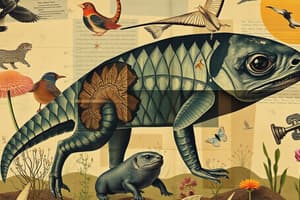Podcast
Questions and Answers
Which organ is responsible for storing bile?
Which organ is responsible for storing bile?
- Pancreas
- Liver
- Gallbladder (correct)
- Stomach
What is the primary function of the large intestine?
What is the primary function of the large intestine?
- Nutrient absorption
- Lipid breakdown
- Protein digestion
- Water reabsorption (correct)
Which of these is a digestive disorder that directly affects the small intestine?
Which of these is a digestive disorder that directly affects the small intestine?
- Heartburn
- Diverticulitis
- Appendicitis
- Celiac disease (correct)
What is the role of the pancreas in digestion?
What is the role of the pancreas in digestion?
Which of these is NOT a function of the liver related to digestion?
Which of these is NOT a function of the liver related to digestion?
What is the primary function of peristalsis in the digestive system?
What is the primary function of peristalsis in the digestive system?
Which of the following is NOT a function of saliva?
Which of the following is NOT a function of saliva?
What is the primary site of nutrient absorption in the human digestive system?
What is the primary site of nutrient absorption in the human digestive system?
How does the platypus's digestive system differ from other mammals?
How does the platypus's digestive system differ from other mammals?
What is the role of the epiglottis in the digestive process?
What is the role of the epiglottis in the digestive process?
Flashcards
Villi
Villi
Small, finger-like projections in the intestine that absorb nutrients.
Large Intestine
Large Intestine
A part of the digestive system responsible for water reabsorption and storing feces.
Liver
Liver
The largest internal organ, involved in digestion, metabolism, and bile production.
Rectum
Rectum
Signup and view all the flashcards
Celiac Disease
Celiac Disease
Signup and view all the flashcards
Platypus digestion
Platypus digestion
Signup and view all the flashcards
Human digestive tasks
Human digestive tasks
Signup and view all the flashcards
Role of saliva
Role of saliva
Signup and view all the flashcards
Stomach functions
Stomach functions
Signup and view all the flashcards
Small intestine absorption
Small intestine absorption
Signup and view all the flashcards
Study Notes
The Platypus and Digestion
- Platypuses are egg-laying mammals.
- Males have venomous spurs on their legs.
- Platypuses lack a traditional stomach, lacking gastric glands and gastric juice production.
- Their digestive system differs from other mammals, illustrating evolutionary diversity.
Human Digestive System
- The human digestive system performs ingestion, digestion, absorption, and elimination.
- Food is ingested through the mouth.
- Digestion breaks down biomolecules (carbohydrates, lipids, proteins, nucleic acids) into smaller units.
- Absorption transports nutrients into the bloodstream.
- Elimination removes unused materials.
Mouth
- Saliva contains salivary amylase, initiating carbohydrate digestion.
- Teeth mechanically break down food.
- Saliva neutralizes acidity, preventing tooth decay.
- The tongue forms chewed food into a bolus for swallowing.
Esophagus
- The epiglottis prevents food from entering the windpipe.
- Peristalsis, wave-like muscle contractions, moves food to the stomach.
Stomach
- The stomach holds about 2 liters.
- Gastric juice, containing hydrochloric acid (HCL) and pepsin for protein digestion, makes it acidic.
- Stomach churning mixes food and gastric juices, creating chyme.
- Sphincters control food movement between the esophagus, stomach, and intestines.
- A protective mucus layer shields the stomach lining from digestion.
Small Intestine
- The duodenum, jejunum, and ileum form the small intestine - the primary site for all biomolecule digestion.
- Enzymes from the liver, gallbladder, and pancreas aid chemical digestion.
- Peristalsis mechanically digests food.
- Nutrients (glucose, fructose, amino acids, electrolytes, vitamins, lipids) are absorbed.
- Intestinal villi and microvilli increase absorption surface area.
- Villi are vascularized for nutrient transport into capillaries.
Large Intestine (Colon)
- Beneficial bacteria in the large intestine aid digestion and vitamin production.
- Water reabsorption is the large intestine's main function.
- Feces, composed of undigested materials and bacteria, are formed.
Rectum and Anus
- The rectum stores feces until elimination.
- Feces exit through the anus.
Accessory Organs
- The liver, a large internal organ, performs functions beyond digestion.
- In digestion, the liver processes carbohydrates and proteins, producing bile for lipid breakdown.
- The gallbladder stores bile.
- The pancreas produces digestive enzymes and neutralizes acidic chyme.
Hormones and Digestive Disorders
- Hormones control digestive processes.
- Digestive disorders include celiac disease (small intestine), diverticulitis (large intestine), and heartburn (acid reflux).
Conclusion
- The human digestive system efficiently breaks down food, absorbs nutrients, and removes waste.
- Understanding the system is key for maintaining health and managing digestive issues.
Studying That Suits You
Use AI to generate personalized quizzes and flashcards to suit your learning preferences.





